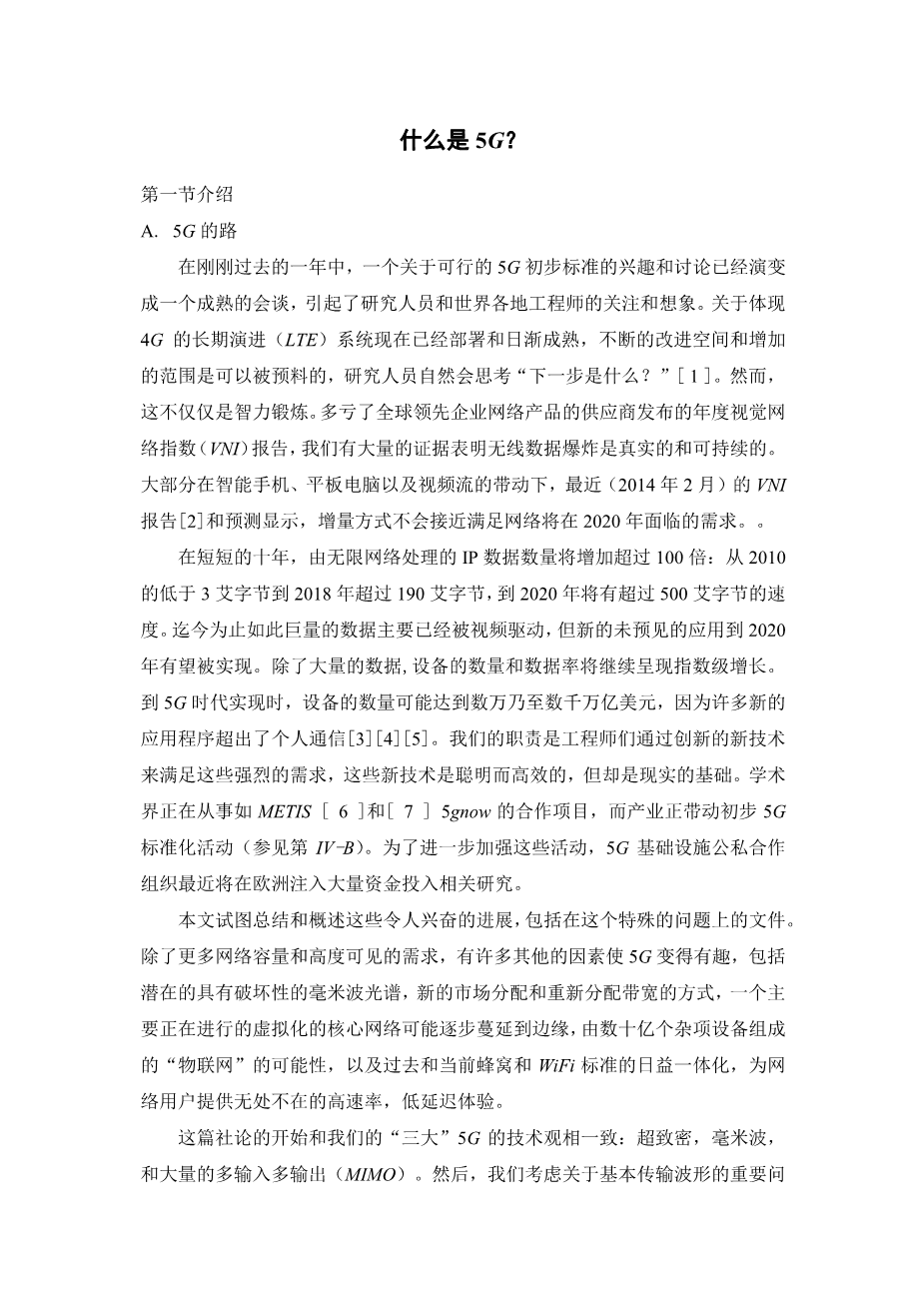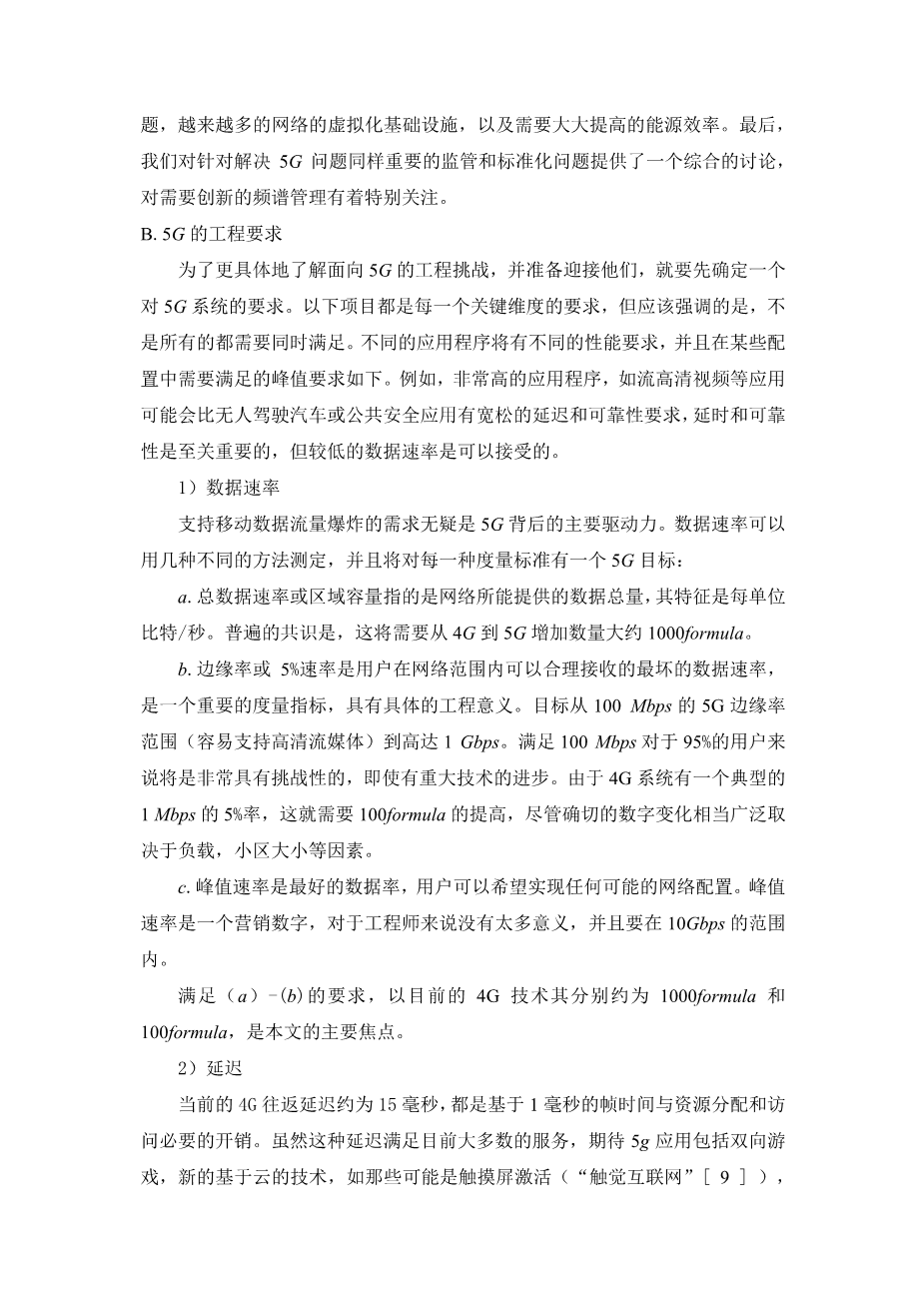What Will 5G Be?
SECTION I INTRODUCTION
A. The Road to 5G
In just the past year, preliminary interest and discussions about a possible 5G standard have evolved into a full-fledged conversation that has captured the attention and imagination of researchers and engineers around the world. As the long-term evolution (LTE) system embodying 4G has now been deployed and is reaching maturity, where only incremental improvements and small amounts of new spectrum can be expected, it is natural for researchers to ponder “whats next?”[1]. However, this is not a mere intellectual exercise. Thanks largely to the annual visual network index (VNI) reports released by Cisco, we have quantitative evidence that the wireless data explosion is real and will continue. Driven largely by smartphones, tablets, and video streaming, the most recent (Feb. 2014) VNI report[2] and forecast makes plain that an incremental approach will not come close to meeting the demands that networks will face by 2020.
In just a decade, the amount of IP data handled by wireless networks will have increased by well over a factor of 100: from under 3 exabytes in 2010 to over 190 exabytes by 2018, on pace to exceed 500 exabytes by 2020. This deluge of data has been driven chiefly by video thus far, but new unforeseen applications can reasonably be expected to materialize by 2020. In addition to the sheer volume of data, the number of devices and the data rates will continue to grow exponentially. The number of devices could reach the tens or even hundreds of billions by the time 5G comes to fruition, due to many new applications beyond personal communications[3] [4][5]. It is our duty as engineers to meet these intense demands via innovative new technologies that are smart and efficient yet grounded in reality. Academia is engaging in collaborative projects such as METIS[6] and 5GNOW [7], while industry is driving preliminary 5G standardization activities (cf. Section IV-B). To further strengthen these activities, the public-private partnership for 5G infrastructure recently constituted in Europe will funnel massive amounts of funds into related research[8].
This article is an attempt to summarize and overview many of these exciting developments, including the papers in this special issue. In addition to the highly visible demand for ever more network capacity, there are a number of other factors that make 5G interesting, including the potentially disruptive move to millimeter wave (mmWave) spectrum, new market-driven ways of allocating and re-allocating bandwidth, a major ongoing virtualization in the core network that might progressively spread to the edges, the possibility of an “Internet of Things” comprised of billions of miscellaneous devices, and the increasing integration of past and current cellular and WiFi standards to provide a ubiquitous high-rate, low-latency experience for network users.
This editorial commences with our view of the “big three” 5G technologies: ultra-densification, mmWave, and massive multiple-input multiple-output (MIMO). Then, we consider important issues concerning the basic transmission waveform, the increasing virtualization of the network infrastructure, and the need for greatly increased energy efficiency. Finally, we provide a comprehensive discussion of the equally important regulatory and standardization issues that will need to be addressed for 5G, with a particular focus on needed innovation in spectrum regulation.
B. Engineering Requirements for 5G
In order to more concretely understand the engineering challenges facing 5G, and to plan to meet them, it is necessary to first identify the requirements for a 5G system. The following items are requirements in each key dimension, but it should be stressed that not all of these need to be satisfied simultaneously. Different applications will place different requirements on the performance, and peak requirements that will need to be satisfied in certain configurations are mentioned below. For example, very-high-rate applications such as streaming high-definition video may have relaxed latency and reliability requirements compared to driverless cars or public safety applications, where latency and reliability are paramount but lower data rates can be tolerated.
1) Data Rate
The need to support the mobile data traffic explosion is unquestionably the main driver behind 5G. Data rate can be measured in several different ways, and there will be a 5G goal target for each such metric:
a.Aggregate data rate or area capacity refers to the total amount of data the network can serve, characterized in bits/s per unit area. The general consensus is that this quantity will need to increase by roughly 1000Formula from 4G to 5G.
b.Edge rate or 5% rate is the worst data rate that a user can reasonably expect to receive when in range of the network, and so is an important metric and has a concrete engineering meaning. Goals for the 5G edge rate range from 100 Mbps (easily enough to support high-definition streaming) to as much as 1 Gbps. Meeting 100 Mbps for 95% of users will be extraordinarily challenging, even with major technological advances. This requires about a 100Formula advance since current 4G systems have a typical 5% rate of about 1 Mbps, although the precise number varies quite widely depending on the load, the cell size, and other factors.
c.Peak rate is the best-case data rate that a user can hope to achieve under any conceivable network configuration. The peak rate is a marketing number, devoid of much meaning to engineers and likely to be in the range of tens of Gbps.
Meeting the requirements in (a)-(b), which are about 1000Formula and 100Formula current 4G technology, respectively, are the main focus of this paper.
2) Latency
Current 4G roundtrip latencies are on the order of about 15 ms, and are based on the 1 ms subframe time with necessary ov
剩余内容已隐藏,支付完成后下载完整资料


英语译文共 12 页,剩余内容已隐藏,支付完成后下载完整资料
资料编号:[613747],资料为PDF文档或Word文档,PDF文档可免费转换为Word
课题毕业论文、文献综述、任务书、外文翻译、程序设计、图纸设计等资料可联系客服协助查找。


